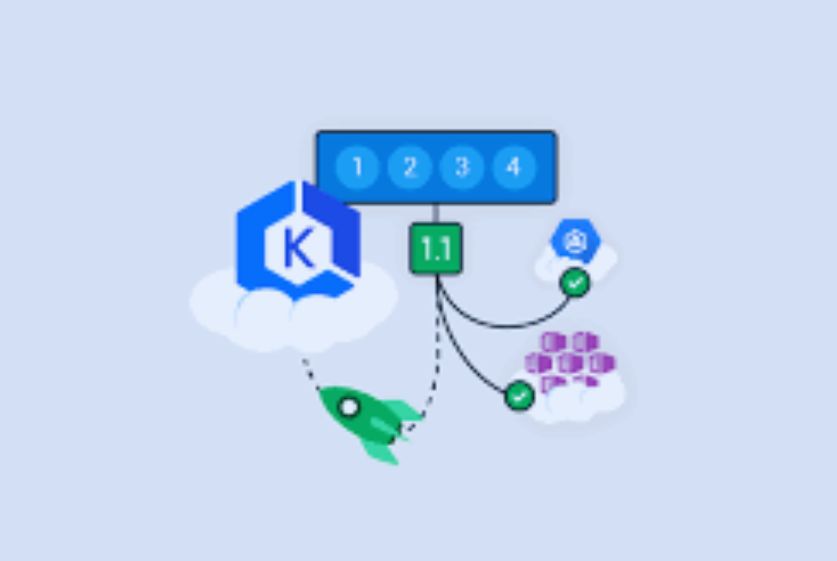Kubernetes has quickly become one of the most popular platforms for deploying containerized applications. With its powerful orchestration and management capabilities, Kubernetes enables enterprises to efficiently run container workloads at scale. As organizations expand their use of containers, questions arise about running Kubernetes across multiple clouds.
What are the key benefits and challenges of this multi-cloud Kubernetes approach? How does it compare to a single environment? In this comprehensive guide, we’ll dig into everything you need to know about deploying Kubernetes in a multi-cloud architecture.
Table of Contents
What is Kubernetes?
First, a quick overview for those less familiar. Kubernetes (also known as K8s) is an open-source platform for automating the deployment, scaling, and operations of containerized applications. It groups containers into logical clusters and provides easy mechanisms for managing those clusters.
Key benefits of Kubernetes include:
- Automated rollouts and rollbacks – Kubernetes progressively rolls out changes to applications while monitoring application health to ensure no downtime.
- Storage orchestration – Automatically mount storage systems to the correct application containers no matter where they move in a cluster.
- Self-healing – Restarts containers automatically if they fail or stop responding.
- Horizontal scaling – Scale-out applications seamlessly based on demand.
- Service discovery and load balancing – Containers receive their IP addresses for easy service discovery between application components. Load balancing then distributes traffic across containers appropriately.
As these features demonstrate, Kubernetes provides powerful advantages for running containerized workloads. But what happens when we extend Kubernetes across multiple cloud environments?
What is Multi-Cloud?
A multi-cloud architecture refers to using two or more public clouds – for example, utilizing both AWS and Azure simultaneously. Organizations take this approach for various reasons:
- Avoid vendor lock-in
- Deploy applications closer to end users
- Meet local data residency laws
- Improve resiliency
- Optimize costs
Running Kubernetes across multiple clouds provides increased flexibility but also introduces greater complexity. We’ll explore the full implications later on.
First, let’s look at deployment options and tools for managing Kubernetes in a multi-cloud environment.
Deploying Kubernetes Across Multiple Clouds
To deploy Kubernetes across multiple clouds, organizations must make several key decisions:
- Which cloud infrastructure options to utilize?
- What Kubernetes infrastructure provisioning and configuration management tools to employ?
Let’s explore leading choices for both areas.
Cloud Infrastructure Options
All major cloud providers offer fully managed Kubernetes services that reduce infrastructure administrative burdens. These include:

AWS
- Amazon Elastic Kubernetes Service (EKS): Amazon’s fully-managed Kubernetes offering is tightly integrated into other AWS services.
Azure
- Azure Kubernetes Service (AKS): Microsoft’s hosted Kubernetes environment streamlined for Azure cloud resources.
Google Cloud
- Google Kubernetes Engine (GKE): Google’s fully-managed Kubernetes optimized for integration into other Google Cloud services.
Many organizations utilize two or more of these when building multi-cloud Kubernetes architectures.
Multi-Cloud Kubernetes Tools
Cloud-provided Kubernetes platforms, leveraging tools like Terraform, Ansible, and Helm bring several advantages:

Terraform
Terraform allows administrators to define cloud infrastructure environments in code. This improves consistency and enables versioning of infrastructure changes. Terraform supports provisioning resources across public clouds.
Ansible
Ansible serves as a configuration management tool to streamline OS and Kubernetes cluster configuration. Ansible integrates modules from all major cloud providers. Playbooks enable configuring Kubernetes components consistently across environments.
Helm
While base Kubernetes functionality remains consistent across installations, cloud-provider integrations and optimizations still vary. This is where Helm brings value. Helm defines, installs, and manages Kubernetes applications via templatized “charts”. Charts encapsulate functionality into portable packages that function uniformly regardless of the target cloud.
By combining infrastructure as code tools like Terraform with configuration management (Ansible) and application packaging approaches (Helm), multi-cloud Kubernetes achieves greater consistency.
Multi-Cloud Kubernetes Use Cases
Now that we’ve covered the foundations of a multi-cloud Kubernetes architecture, let’s explore common use cases driving the adoption of this approach:

Disaster Recovery and Business Continuity
Mission-critical applications require an always-on approach with no single point of failure. While redundancy within a single cloud region helps, distributing apps across cloud providers facilitates isolating failure domains even further minimizing potential downtime. Multi-cloud Kubernetes delivers infrastructure diversity to meet demanding resiliency and business continuity needs.
Avoiding Vendor Lock-in
If all applications run only on AWS or Azure, migrating workloads to an alternate platform poses substantial challenges. Multi-cloud Kubernetes enables application portability across back ends avoiding lock-in to a single provider. This preserves flexibility to shift workloads in response to economic, technological, or regulatory changes.
Optimizing Costs
Not all infrastructure spend maps cleanly across clouds. By running Kubernetes across multiple environments, organizations gain flexibility to optimize placement and resource allocation balancing performance and budget requirements.
Workloads can run on AWS when bursting capacity for batch jobs and migrate to lower-cost Azure infrastructure for steady-state processing. Managed intelligently, multi-cloud efficiencies rapidly add up.
Low-Latency Applications
Latency remains a fact of life in cloud-based applications. Speed of light combined with round-trip network lag intrinsically bounds responsiveness. Multi-cloud Kubernetes sidesteps physics through distributed topologies placing application components near end users and minimizing geographical distance. This geo-proximity approach speeds the delivery of content, shields users from outages, and provides responsive experiences.
These scenarios illustrate driving motivations for deploying Kubernetes across multiple clouds. But what about the downsides? We cover those next.
Challenges with Multi-Cloud Kubernetes
While utilizing Kubernetes across clouds opens new doors, it also poses fresh challenges including:
Increased Complexity
Maintaining consistent Kubernetes functionality across multiple clouds grows complexity exponentially. Minor environmental differences quickly cascade into deployment and management headaches if not carefully controlled. Without implementing infrastructure as code and rigorous DevOps automation, complexity diversion sucks up valuable engineering time.
Managing Multiple Environments
Even with excellent DevOps practices, juggling multiple clouds strains infrastructure management capabilities. Monitoring, logging, troubleshooting, and security rapidly become more intricate across each additional cloud targeted. Without centralized controls and governance, a lack of cross-environment visibility inhibits management at scale.
Moving Data Between Clouds
Modern data-driven applications centralize information to derive value. However centralized data on a single cloud defeats many multi-cloud motivations. Keeping real-time data synchronized across diverse back ends introduces sizable data gravity and compliance hurdles.

Troubleshooting Issues
The distributed nature of multi-cloud apps exponentially magnifies the difficulty in tracing the root causes of problems. Network partitions, unexpected cloud operation variances, and component failures have cascading effects obscuring original issues. Without aggregated logging or distributed tracing infrastructure, troubleshooting billows into a time-consuming slog.
While multi-cloud Kubernetes opens new opportunities, it also risks considerable peril without careful planning and solid cloud operating foundations.
Next, we’ll cover best practices for mitigating these hazards.
Best Practices for Multi-Cloud Kubernetes
Given challenges explored above, how do successful teams overcome issues managing Kubernetes across cloud boundaries? Several key practices provide guidance:

Create a Unified Environment
Re-architect applications leveraging cloud-agnostic technologies facilitating application portability such as:
- Containers – Encapsulate functionality into isolated, portable units
- Service Mesh – Route traffic consistently across environments
- API Gateways – Standardize integration mechanisms externalizing internal changes
These constructs raise cloud abstractions reducing environmental friction and leaks between layers.
Automate Processes
Apply infrastructure as code techniques to introduce repeatability and reduce reliance on tribal knowledge. Source control and peer reviews enforce best practices across teams.
Automated policy enforcement guarantees adherence to standards avoiding configuration drift. Extend CI/CD pipelines deploying applications to span multiple target clouds keeping environments in sync.
Such automation delivers order-taming inherent complexity.
Monitor Closely
Correlating interdependent application flows traversing cloud boundaries grows exponentially more difficult at scale. Implement centralized log aggregation tying disparate signals together into unified dashboards.
Distributed tracing maps intricate cross-component application flows regardless of the underlying infrastructure. Such holistic monitoring and alerting provide missing visibility.
Plan Network Architecture
Mismatched networks trigger myriad connectivity, security, and performance issues. Model network architecture early assessing latency budgets and compliance mandates.
Secure network transit across cloud environments with gateway transit systems and private connectivity options. Redundant networking with failover enables consistent uptime. Such network planning reduces friction enabling applications to focus on business logic rather than infrastructure.
Consider a Service Mesh
As mentioned above, a service mesh abstracts away network complexities. It handles cross-cutting concerns like tracing, security, routing, resilience patterns, and more. Leading options like Istook work across all major clouds.
This infrastructure layer removed from application code simplifies building distributed applications. Service mesh capabilities enhance reliability, observability, and security posture across ephemeral multi-cloud environments.
Adopting these guidelines empowers organizations to benefit from multi-cloud architectures while controlling risks. As more enterprises take this route, ecosystem maturity will continue advancing.
The Future of Multi-Cloud Kubernetes
Multi-cloud Kubernetes adoption remains in its early phases but its future looks bright given the trajectory:
Further Simplification
As organizations recognize the challenges outlined earlier, cloud providers will continue streamlining management burdens. Expect closer integration between orchestration tools and cloud-managed Kubernetes offerings (EKS, AKS, GKE) improving simplicity.
Tighter Cloud Integrations
Currently, multi-cloud Kubernetes relies heavily on open source with organizations piecing together solutions. As customer demands grow, anticipate cloud vendors delivering tighter multi-cloud orchestration products themselves increasing uniformity and alignment.
Expansion to New Environments
Most multi-cloud Kubernetes today center on AWS, Azure, and Google Cloud. But as hybrid cloud utilization grows, expect integration to extend to on-premises and edge environments also via unified management planes.
Increasing Enterprise Adoption
Once sufficient ecosystem maturity achieves critical mass, expect multi-cloud Kubernetes to expand beyond cutting-edge Internet firms. At that inflection point, the approach becomes viable for enterprises at large seeking cloud choice and flexibility.
Kubernetes across multiple clouds unlocks new potential but requires navigating fresh obstacles. Using the guidelines covered here significantly smooths this journey – both today and even more so in the future as the model continues progressing.
Conclusion
Multi-cloud Kubernetes architectures offer notable advantages but also new challenges requiring planning and governance to manage. When done well, organizations gain increased resilience, avoid vendor lock-in, optimize costs and placement, and enable low-latency global applications.
Key best practices include creating unified abstractions across environments, extensive automation, comprehensive monitoring, and implementing cloud-agnostic technologies like service mesh. These pave the way for realizing benefits while controlling downsides.
As ecosystem tooling matures, expect multi-cloud Kubernetes to expand in usage and deliver simplified operational models to further accelerate adoption. The future remains bright for this emerging approach to running containerized workloads.
FAQs
What are the main benefits of a multi-cloud Kubernetes architecture?
The leading benefits include improving business continuity, avoiding vendor lock-in, reducing costs through selectivity, and enabling low latency via the geo-proximity of application components.
What are the key challenges with managing Kubernetes across multiple clouds?
Top challenges comprise added complexity, lack of visibility across environments, moving data between clouds, and difficulty troubleshooting distributed application flows across cloud boundaries.
How can organizations simplify multi-cloud Kubernetes?
Adopting abstractions via containers, service mesh, and API gateways raises environment independence. Automation, infrastructure as code techniques, and consistent deployment processes greatly reduce complexity.
What types of applications work best using multi-cloud Kubernetes?
Applications requiring very high resiliency, low latency via regional placement, frequent scaling, or portable architecture benefit most from multi-cloud Kubernetes.
What does the future hold for multi-cloud Kubernetes adoption?
As ecosystem tooling improves, complexity decreases, integration across clouds tightens, and more enterprises start utilizing cloud diversity, expect dramatic growth in multi-cloud Kubernetes deployments.









